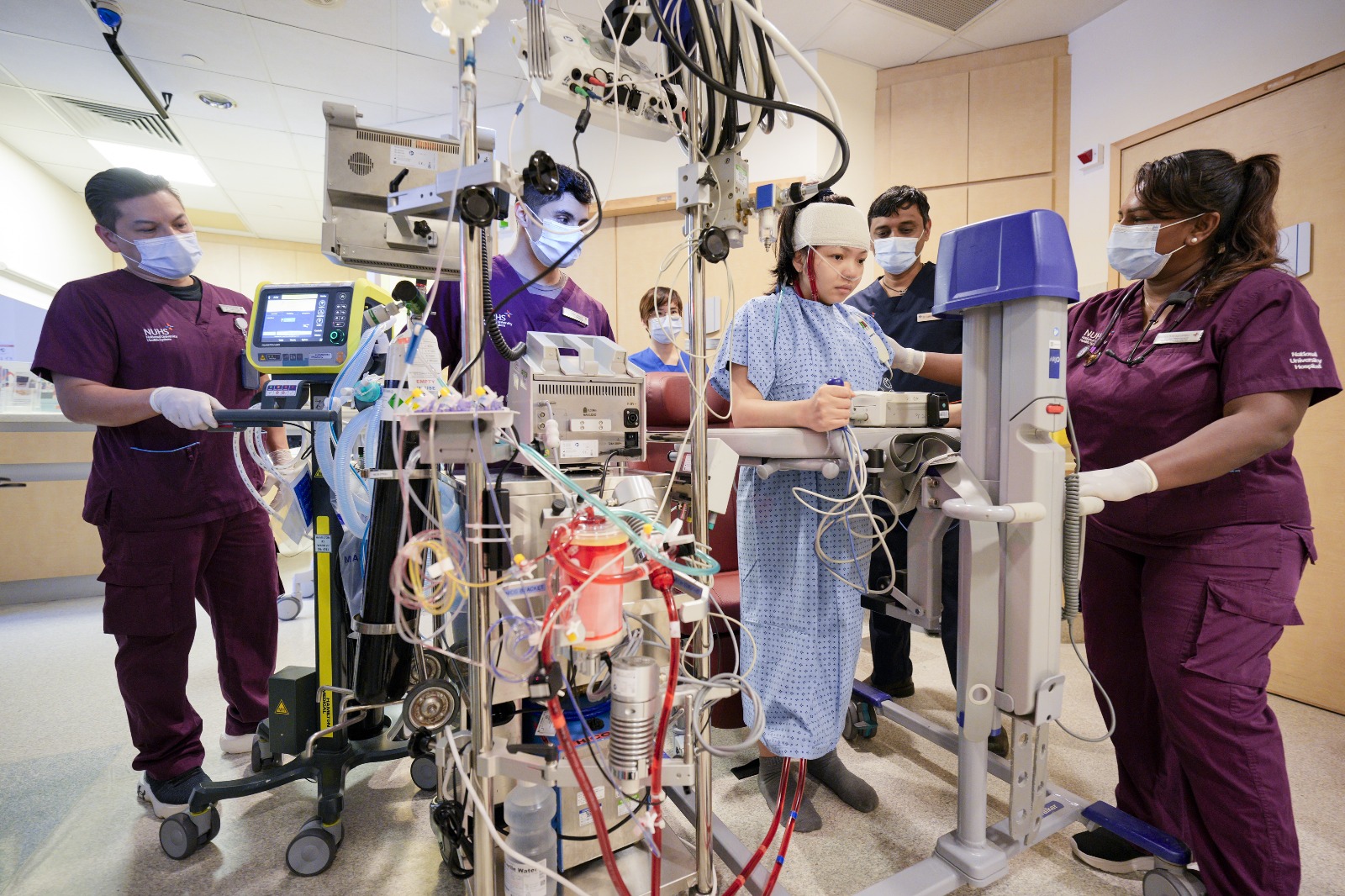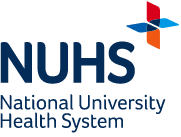Awake life support and early rehabilitation efforts by multidisciplinary team at NUHCS and NUH help young patients regain strength after life-threatening illnesses

A multidisciplinary team from NUHCS and NUH working on a physical rehabilitation programme with an awake ECMO patient to improve muscle strength and speed up recovery (Photo credit: NUHS)
SINGAPORE — When 30-year-old Nathan Tan* was placed on extracorporeal life support after a particularly aggressive bout of pneumonia and eventually required a below-the-knee amputation, he thought he would be never able to dance again. When 22-year-old nursing student Gwendolyn Lye was placed on extracorporeal life support due to a failing heart, she wondered if she would survive. Fortunately for both young patients, they not only pulled through – they returned to doing what they love, thanks to early and intensive rehabilitation efforts that began while they were still critically ill.
Their journeys highlight the life-changing impact of rehabilitation during and after Extracorporeal Membrane Oxygenation (ECMO) life support, a highly specialised and complex form of life support that takes over the functions of the heart and lungs when no other treatment works.
At the National University Heart Centre, Singapore (NUHCS) and the National University Hospital (NUH), a dedicated multidisciplinary team has been leading efforts to integrate rehabilitation into ECMO care, including a rare but promising approach: awake ECMO – a form of ECMO performed when patients are awake.
Fighting ICU-acquired weakness
Studies have shown that critically-ill patients, especially those in the intensive care unit (ICU), are at high risk of developing ICU-acquired weakness, a debilitating condition that can develop within the first 10 days of ICU admission.1, 2 Muscle loss in such patients is rapid and severe, where a quarter of muscle mass can be lost in just four days, and up to 50 per cent within a week. This often leads to longer hospital stays, higher mortality, and significant declines in quality of life and physical function.
Patients on ECMO are particularly vulnerable, as they are traditionally sedated and placed in a medically induced coma for an average of seven to 10 days. But at NUHCS, a national referral centre for patients needing advanced cardiopulmonary support such as ECMO, new approaches are shifting this paradigm.
Rehabilitation while on life support
Since last year, the NUHCS CTICU has successfully performed awake ECMO on four patients, with Gwendolyn being one of them.
As her heart was too weak for general anaesthesia, Gwendolyn remained conscious when she was put on ECMO. While on life support, her care team, which included CTICU nurses and physiotherapists, initiated gentle exercise sessions, which included assisted stretching and mobility drills, to prevent rapid loss of muscle mass.
Research has shown that in ICU patients, early physical rehabilitation can alleviate or prevent weakness syndromes, improve muscle strength, as well as decrease the duration of mechanical ventilation and length of ICU and hospital stay3,4.
Dr Geetha Kayambu, Principal Physiotherapist and Lead in Physiotherapy Research at the Department of Rehabilitation at NUH, said: “The incorporation of physical rehabilitation exercise can prevent and mitigate the effects of ICU-acquired weakness, but this is particularly challenging in unconscious ECMO patients. By assisting patients with targeted movements while on awake ECMO, we help them return to function sooner which shortens their recovery time.”
Gwendolyn was eventually able to come off ECMO in just four days, half the average time for a patient on traditional ECMO. She has since recovered well and returned to her nursing studies.
Her quick recovery and return to good health highlight the potential of awake ECMO in supporting not just survival, but faster and more complete recovery.
Returning to the rhythm of life
Adjunct Associate Professor Ramanathan K.R., Senior Consultant in the Cardiothoracic ICU, Department of Cardiac, Thoracic and Vascular Surgery (CTVS) at NUHCS said: “We know that not all patients are suitable candidates for awake ECMO. Patient selection is critical, and we consider factors such as the severity of illness, ability to maintain a clear airway and tolerate life support while fully conscious. For some, traditional ECMO with sedation remains the safest approach.”
In March 2023, Nathan had to be placed in an induced coma and connected to ECMO for a month after being diagnosed with severe pneumonia. While he eventually recovered following the ECMO procedure, his infection had caused gangrene, leading to a leg amputation.
An avid dancer, Nathan feared he would never be able to live a normal life again. However, with his strong willpower and support from his rehabilitation team, Nathan has not only gone back to work, but has also returned to dancing.
His first milestone post-surgery was to sit up and participate in exercises with the ICU physiotherapist during ECMO. Gradually, he progressed to building lower body strength through stationary cycling using cycle ergometry. Following his discharge from NUH, Nathan continued rehabilitation for six months at Alexandra Hospital (AH).
With hard work and perseverance, he eventually returned to the dance floor with a prosthetic leg in February 2024.
Nathan fondly recalls how his physiotherapists at NUHCS, NUH and AH had supported him every step of the way in his recovery journey, incorporating dance-inspired movements into his rehabilitation exercises after they realised that dancing was a core part of his identity. Their encouragement played a pivotal role in helping him regain confidence and eventually return to the art form he loves.
For both Nathan and Gwendolyn, their recovery emphasises how early and targeted rehabilitation, both during and post-ECMO, is key to restoring quality of life. Their stories also underscore the vital role of multidisciplinary teamwork in every stage of a patient’s healing journey.
*Individual’s name has been changed
To download the PDF version of the media release, click here.
1 Fazzini, B., Märkl, T., Costas, C. et al. The rate and assessment of muscle wasting during critical illness: a systematic review and meta-analysis. Crit Care 27, 2 (2023). https://doi.org/10.1186/s13054-022-04253-0.
2 Hayes K, Holland AE, Pellegrino VA, Mathur S, Hodgson CL. Acute skeletal muscle wasting and relation to physical function in patients requiring extracorporeal membrane oxygenation (ECMO). J Crit Care. 2018 Dec;48:1-8. doi: 10.1016/j.jcrc.2018.08.002. Epub 2018 Aug 7. PMID: 30118978.
3 Kayambu G, Boots R, Paratz J. Physical therapy for the critically ill in the ICU: a systematic review and meta-analysis. Crit Care Med. 2013 Jun;41(6):1543-54. doi: 10.1097/CCM.0b013e31827ca637. PMID: 23528802.
4 Paratz, J. D., & Kayambu, G. (2011). Early exercise and attenuation of myopathy in the patient with sepsis in ICU. Physical Therapy Reviews, 16(1), 58–65. https://doi.org/10.1179/1743288X11Y.0000000002


















